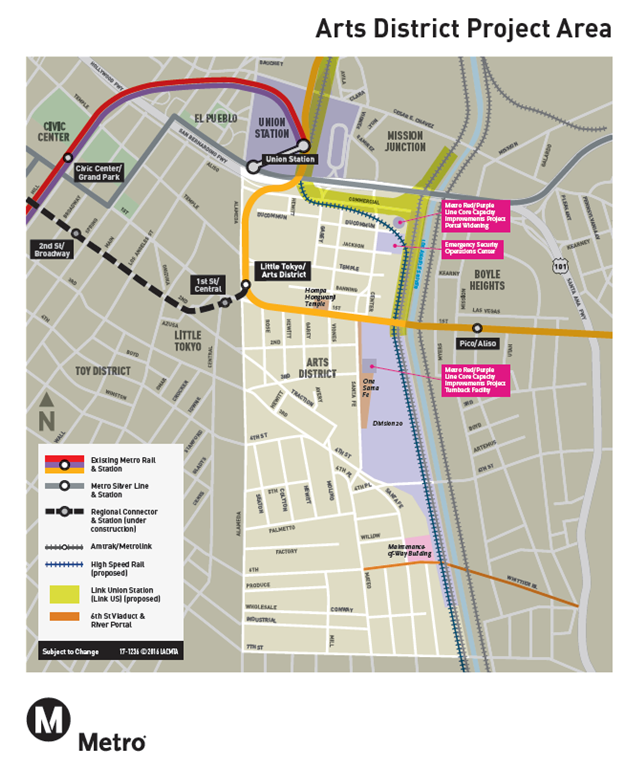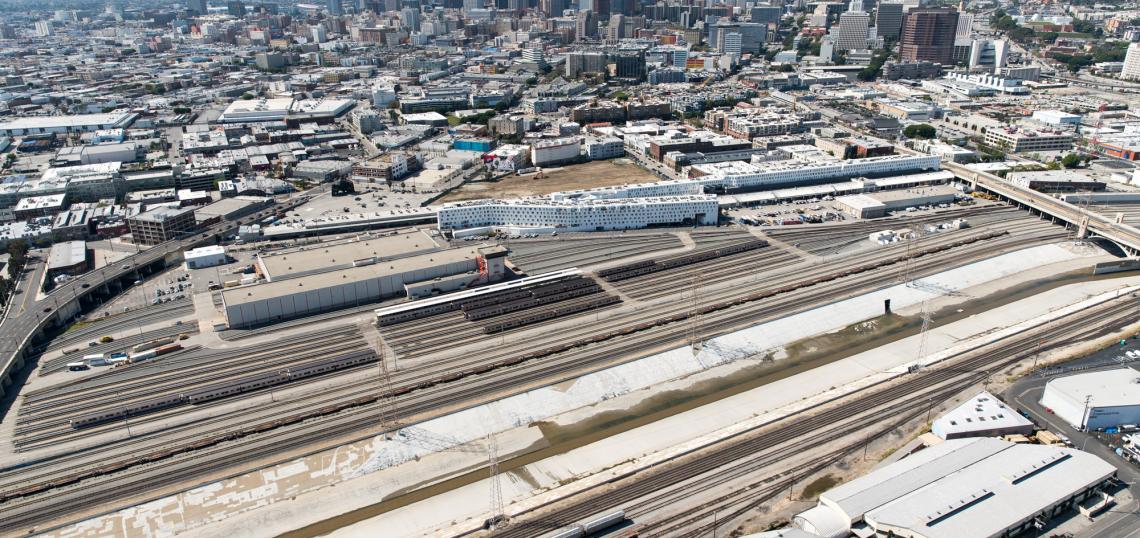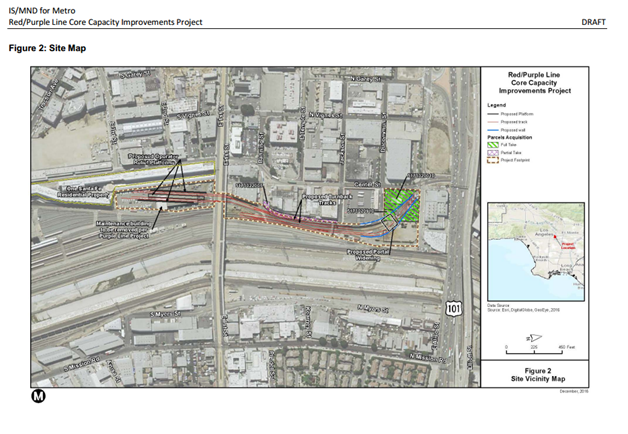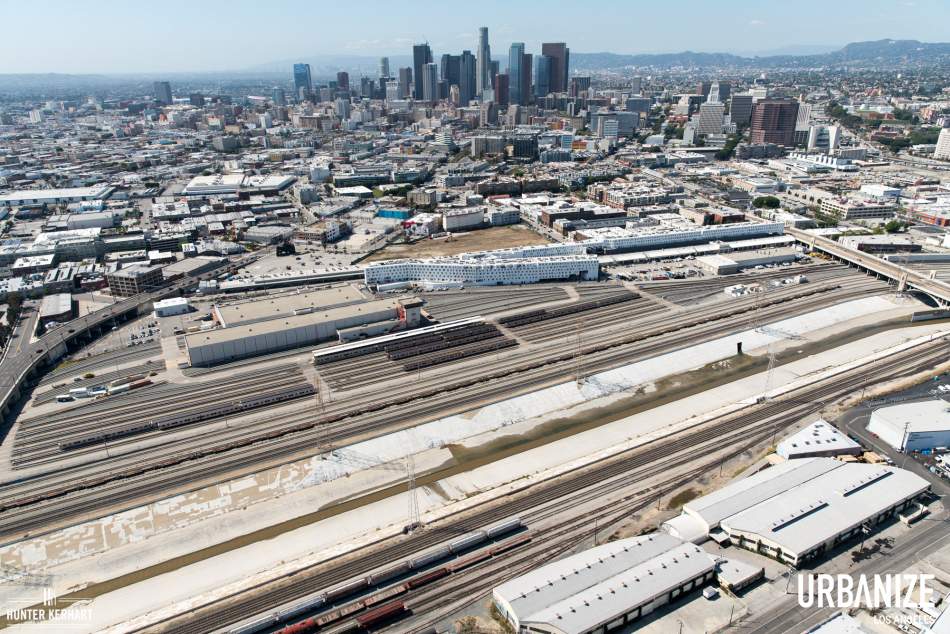Last Wednesday evening, Metro staff gave a presentation to the Historic Cultural Neighborhood Council's Urban Design/Land Use Committee meeting regarding the planned capital improvements to the Division 20 rail yard. Division 20 is a tightly confined network of non-revenue tracks bordered on one side by One Santa Fe apartment complex and on the other by rights-of-way for Burlington North Santa Fe railroad. In anticipation of the opening of the Purple Line Extension, which voters recently voted to accelerate via Measure M, Metro will be constructing a new turnback facility in the yard and widening the portal through which trains transition to surface level. This work, proposed to begin in 2019, will allow the agency to run both the Red and Purple Lines at four-minute headways during peak hours. Although the Mitigated Negative Declaration covered only this work, it was not the main reason that a standing-room only crowd had gathered at SCI-Arc.
That group, an assortment of Arts District residents and developers, was eager to hear Metro’s response to circulating rumors that the agency had ruled out extending the Red and Purple Lines to 6th Street. Metro’s David Mieger, of transit corridor planning, admitted that they had not been expecting such a fevered response to what was thought to be a “benign” project. Nonetheless, he spent the next hour gamely fielding questions on whether heavy rail could service downtown’s easternmost neighborhood, and how community advocates could press the MTA to consider the project.
The idea of extending revenue service through Union Station dates back to the transit system’s early days. The Red Line was to extend to the Eastside before funding and political infighting permanently halted those plans in the 1990s. Presently, it takes approximately four minutes to turn trains around at Union Station. In order to provide the capacity increase that the nine-mile Purple Line Extension will require, Metro needs to construct a turnback facility in the maintenance yard so that trains can pass through Union Station without slowing down to switch tracks. The turnback facility has been considered an opportunity for a relatively cheap rail extension since at least 2010, when former Los Angeles City Councilmember Tom LaBonge directed a study of the feasibility of such a project. That study found that constructing the turnback facility would entail much of the necessary infrastructure for revenue service. Another station site, by the 6th street bridge, was identified as possible, if potentially more costly due to the track reconfigurations that would be required beyond the scope of the turnback facility project. Metro staff were directed to continue planning the Division 20 improvements in coordination with the Purple Line environmental reports , and to preserve the opportunity for potential revenue stations in their design work.
The matter resurfaced in 2015, when another report appeared, exploring the possibility of two heavy rail stops in the Arts District in conjunction with other projects throughout the neighborhood. In the intervening five years, the Arts District had transformed from a quiet community of loft-dwellers and industrial warehouses into a blossoming residential and commercial center. Former Metro CEO Art Leahy spoke enthusiastically about the project, and the report generated much excitement. However, Leahy departed Metro the next month and the coordination study referenced in the report never surfaced. Asked by the audience, Mieger said on Wednesday that the coordination study had been put off because the turnback facility itself had run into unexpected problems. Metro trains enter Division 20 through a portal just south of the US-101 freeway. Trains travel through that stretch at about five miles per hour, and although that speed reduction is insignificant under Union Station’s current configuration, they will need to be able to move at or near revenue speeds by 2024. The Purple Line EIR did not cover widening the portal to allow for higher train speeds, and the work requires additional study.

Mieger sought to allay the concerns of the crowded room, stating that if service were ever to be extended on these tracks, the work Metro is proposing now is a necessary preliminary step. Staff’s orders to preserve the possibility of either a 3rd street station, a 6th street station, or both in the design work for the yard are still in effect. But residents were often unsatisfied with the reality that many of their questions were beyond his authority to answer, and beyond the scope of what was being planned. Mieger was pressed on several occasions for an admission that Metro had privately ruled out the extension, or that it would conclude its work in Division 20 without ever returning to install revenue stations. At one tense moment, a commenter wondered aloud if advocates for an Arts District station would be better off attempting to obstruct the portal widening, as they now knew it would be necessary for Purple Line operations.
But, in general, the mood was inquisitive rather than combative. Mieger insisted that nothing precluded subway service to the Arts District, besides the fundamental fact that it was not being officially considered and had no funding. The intensity of uses planned in the area among public agencies and private developers would necessitate close cooperation to make an Arts District station happen, he said. Cooperation of the type Metro had previously engaged in when it compromised with residents in the design of the Maintenance-of-Way Building further south. Realizing that this was not the forum where the fate of a 6th Street station would be determined, the group moved on to action items. Residents refocused their attention on next year’s Long Range Transportation Plan, and ways to navigate the bureaucratic thicket of the MTA. As Metro moves to complete this essential work for the Purple Line Extension, transit service to the Arts District remains a suspended possibility, neither directly imperiled, nor materially closer to reality than it was five years ago.
- Rail Yard Improvements Could Preclude Arts District Metro Station (Urbanize LA)
- Arts District Subway Extension Still Alive (Urbanize LA)








